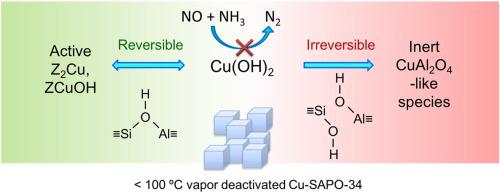Applied Catalysis B: Environment and Energy ( IF 22.1 ) Pub Date : 2020-07-10 , DOI: 10.1016/j.apcatb.2020.119306 Yue Ma , Xiaodong Wu , Liping Liu , Li Cao , Rui Ran , Zhichun Si , Feng Gao , Duan Weng

|
Cu-SAPO-34 selective catalytic reduction (SCR) catalyst deactivates upon exposure to water vapor at temperatures lower than 100 °C, which deteriorates its application prospects. The deactivation under cycled aging-regeneration conditions can be categorized into two stages, namely reversible and irreversible deactivation. Based on SCR reaction tests, and characterizations with diffuse reflection infrared Fourier transform spectroscopy (DRIFTS), NH3 temperature-programmed desorption (NH3-TPD) and H2 temperature-programmed reduction (H2-TPR), it is concluded that the transformation of active isolated Cu(II) ions to Cu(OH)2 is critical to both types of deactivation. Within the frame of reversible deactivation, Cu(OH)2 can be converted back to SCR active Cu(II) ions by interacting with Brønsted acid sites during high-temperature regeneration. However, interactions between Cu(OH)2 and hydrolyzed framework Al lead to the formation of CuAl2O4-like species, causing permanent loss of active Cu(II) ions and thus, irreversible deactivation.
中文翻译:

Cu(OH)2在低温水分诱导的Cu-SAPO-34 SCR催化剂降解中的关键作用:关联可逆和不可逆失活
Cu-SAPO-34选择性催化还原(SCR)催化剂在低于100°C的温度下暴露于水蒸气时会失活,从而降低了其应用前景。循环老化-再生条件下的失活可分为两个阶段,即可逆和不可逆失活。基于SCR反应测试,并通过漫反射红外傅里叶变换光谱(DRIFTS),NH 3程序升温脱附(NH 3 -TPD)和H 2程序升温还原(H 2 -TPR)表征,得出结论活性分离的Cu(II)离子向Cu(OH)2的转化对于两种停用方式都至关重要。在可逆失活的框架内,通过在高温再生过程中与布朗斯台德酸位点相互作用,Cu(OH)2可以转化为SCR活性Cu(II)离子。然而,Cu(OH)2和水解的框架Al之间的相互作用导致形成类似CuAl 2 O 4的物质,导致活性Cu(II)离子的永久丢失,因此导致不可逆的失活。


























 京公网安备 11010802027423号
京公网安备 11010802027423号